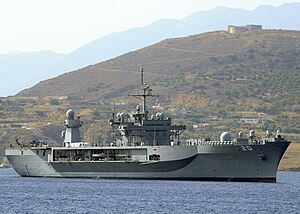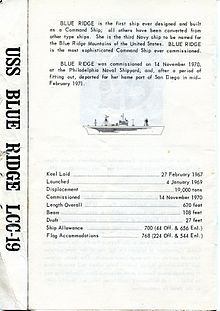
The Gato class of submarines were built for the United States Navy and launched in 1941–1943. Named after the lead ship of the class, USS Gato, they were the first mass-production U.S. submarine class of World War II.

The Austin class was a class of twelve amphibious transport dock ships in service with the United States Navy from 1965 to 2017. Note that the U.S. Naval Vessel Registry list separate Cleveland and Trenton class ships, but most sources lists them as a single class. Trenton was sold to India and is the only ship still active.
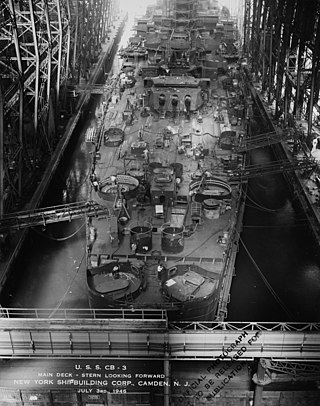
USS Hawaii (CB-3) was intended to be the third member of the Alaska-class large cruisers. It was the first United States Navy ship to be named after the then-Territory of Hawaii. Because Hawaii's construction was delayed by higher-priority ships like aircraft carriers, her keel was not laid until December 1943, about two years after her sister ship Guam.

The third USS Northampton (CLC-1/CC-1) was a US Navy command light cruiser. She was laid down as an Oregon City-class heavy cruiser (CA–125), on 31 August 1944 by the Fore River Yard, Bethlehem Steel Corp., Quincy, Massachusetts. Work suspended between 11 August 1945 and 1 July 1948; she was converted to a command cruiser under project SCB 13 and launched as CLC–1, on 27 January 1951; sponsored by Mrs. Edmond J. Lampron; and commissioned as CLC–1, on 7 March 1953.
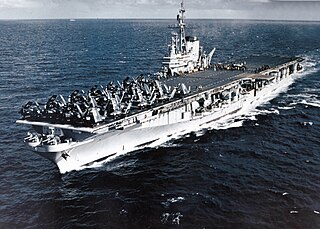
The Midway-class was a class of three United States Navy aircraft carriers. The lead ship, USS Midway, was commissioned in September 1945 and decommissioned in 1992. USS Franklin D. Roosevelt was commissioned in October 1945, and taken out of service in 1977. USS Coral Sea was commissioned in April 1947, and decommissioned in 1990.

USS Blue Ridge (LCC-19) is the lead ship of the two Blue Ridge-class amphibious command ships of the United States Navy, and is the flagship of the Seventh Fleet. Her primary role is to provide command, control, communications, computers, and intelligence (C4I) support to the commander and staff of the United States Seventh Fleet. She is currently forward-deployed to U.S. Navy Fleet Activities, Yokosuka in Japan, and is the third Navy ship named after the Blue Ridge Mountains, a range of mountains in the Appalachian Mountains of the eastern United States. Blue Ridge is the oldest deployed warship of the U.S. Navy, following the decommissioning of USS Denver. Blue Ridge, as the U.S. Navy's active commissioned ship having the longest total period as active, flies the First Navy Jack instead of the jack of the United States. Blue Ridge is expected to remain in service until 2039.

USS Mount Whitney is one of two Blue Ridge-class amphibious command ships of the United States Navy and is the flagship and command ship of the United States Sixth Fleet. USS Mount Whitney also serves as the Afloat Command Platform (ACP) of Naval Striking and Support Forces NATO (STRIKFORNATO). The ship had previously served for years as the COMSTRIKFLTLANT(NATO Designation) / US Second Fleet's command ship. She is one of only a few commissioned ships to be assigned to Military Sealift Command.

The Iwo Jima-class amphibious assault ships of the United States Navy were the first amphibious assault ships designed and built as dedicated helicopter carriers, capable of operating up to 20 helicopters to carry up to 1,800 marines ashore. They were named for battles featuring the United States Marine Corps, starting with the Battle of Iwo Jima. The first ship of the class was commissioned in 1961, and the last was decommissioned in 2002. The hull classification of "LPH" stands for "Landing Platform Helicopter".
The U.S. Navy Electronics Laboratory (NEL) was created in 1945, with consolidation of the naval radio station, radar operators training school, and radio security activity of the Navy Radio and Sound Lab (NRSL) and its wartime partner, the University of California Division of War Research. NEL’s charter was “to effectuate the solution of any problem in the field of electronics, in connection with the design, procurement, testing, installation and maintenance of electronic equipment for the U.S. Navy.” Its radio communications and sonar work was augmented with basic research in the propagation of electromagnetic energy in the atmosphere and of sound in the ocean.

A radar picket is a radar-equipped station, ship, submarine, aircraft, or vehicle used to increase the radar detection range around a nation or military force to protect it from surprise attack, typically air attack, or from criminal activities such as smuggling. By definition a radar picket must be some distance removed from the anticipated targets to be capable of providing early warning. Often several detached radar units would be placed in a ring to encircle a target to provide increased cover in all directions; another approach is to position units to form a barrier line.

An amphibious command ship (LCC) of the United States Navy is a large, special-purpose ship, originally designed to command large amphibious invasions. However, as amphibious invasions have become unlikely, they are now used as general command ships, and serve as floating headquarters for the various combatant commands. Currently, they are assigned to the 6th and 7th Fleets as flagships.

The 3"/50 caliber gun in United States naval gun terminology indicates the gun fired a projectile 3 inches (76 mm) in diameter, and the barrel was 50 calibers long. Different guns of this caliber were used by the U.S. Navy and U.S. Coast Guard from 1900 through to 1990 on a variety of combatant and transport ship classes.

The AN/SPS-48 is a US naval electronically scanned array, air search three-dimensional radar system manufactured by ITT Exelis and deployed in the 1960s as the primary air search sensor for anti-aircraft warships. The deployment of the AN/SPY-1 and the end of the Cold War led to the decommissioning of many such ships, and many of these vessel's AN/SPS-48 sets were reused on aircraft carriers and amphibious ships where it is used to direct targets for air defense systems such as the Sea Sparrow and RIM-116 SAM missiles. Existing sets are being modernized under the ROAR program to AN/SPS-48G standard for better reliability and usability.
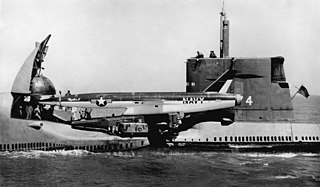
The Grayback-class submarine was a class of two guided missile-carrying submarines of the United States Navy. They carried the Regulus I and Regulus II nuclear cruise missiles, deployed 1957–64, that were rapidly phased out by Polaris Submarine Launched Ballistic Missiles (SLBMs). They and USS Halibut were the sole submarines designed specifically to carry Regulus missiles, and the only submarines capable of carrying Regulus II. However, USS Tunny and USS Barbero were modified earlier to carry two Regulus I missiles per boat.
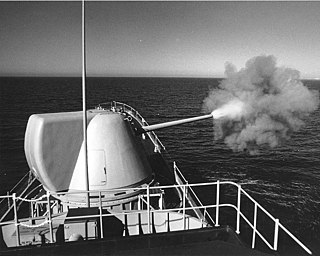
The U.S. Navy's Major Caliber Lightweight Gun (MCLWG) program was the 8"/55 caliber Mark 71 major caliber lightweight, single-barrel naval gun prototype (spoken "eight-inch-fifty-five-caliber") that was mounted aboard the destroyer USS Hull in 1975 to test the capability of destroyer-sized ships to replace decommissioned cruisers for long-range shore bombardment. United States naval gun terminology indicates the gun fired a projectile 8 inches (203 mm) in diameter, and the barrel was 55 calibers long (barrel length is 8" × 55 = 440" or 11.165 meters.)

The Raleigh class of amphibious transport docks served the United States Navy. They were designed under project SCB 187.

The Ashland-class dock landing ship were the first class of dock landing ship of the United States Navy. They were built during World War II. A dock landing ship is a form of auxiliary warship designed to support amphibious operations. Eight ships were built for the United States Navy and they remained in US service until the 1960s. Two of the class were sold for export overseas, with one joining the Republic of China Navy and the other the Argentinian Navy. The two transferred ships stayed in service until the 1980s. All eight ships were scrapped.

The Essex class is a retired class of aircraft carriers of the United States Navy. The 20th century's most numerous class of capital ship, the class consisted of 24 vessels, which came in "short-hull" and "long-hull" versions. Thirty-two ships were ordered, but as World War II wound down, six were canceled before construction, and two were canceled after construction had begun. Fourteen saw combat during World War II. None were lost to enemy action, though several sustained crippling damage. Essex-class carriers were the backbone of the U.S. Navy from mid-1943 and, with the three Midway-class carriers added just after the war, continued to be the heart of U.S. naval strength until supercarriers joined the fleet in the 1950s, 1960s and 1970s. Several of the carriers were rebuilt to handle heavier and faster aircraft of the early jet age, and some served until well after the Vietnam War. Of the 24 ships in the class, four have been preserved as museum ships.

The Ship Characteristics Board was a unit of the United States Navy.
